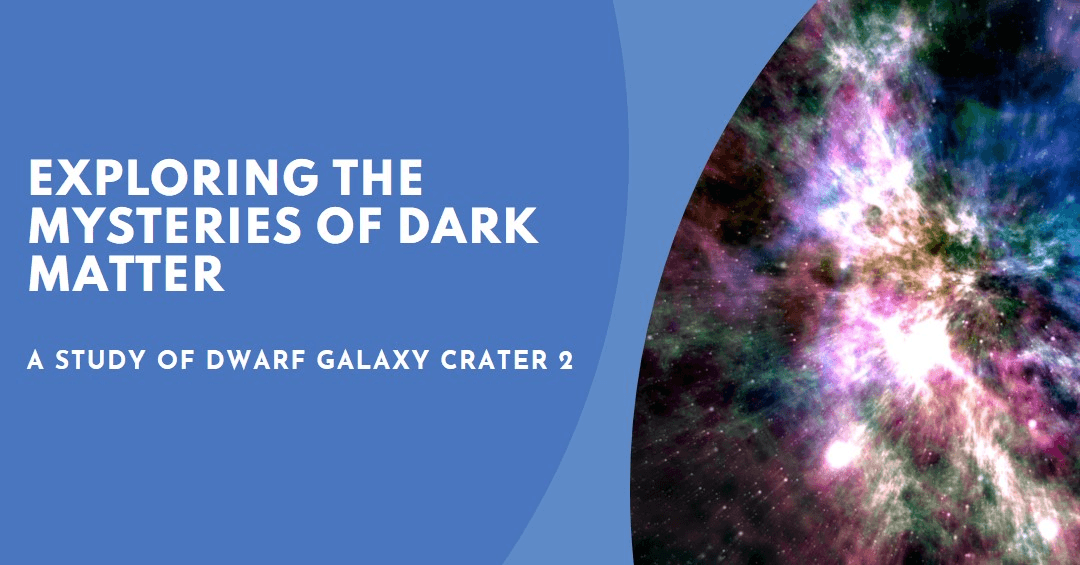The Milky Way’s satellite galaxy, Crater 2, presents a compelling case study in dark matter dynamics. This seemingly contradictory object, boasting large size yet faint luminosity and slow stellar motion, challenges the prevailing Cold Dark Matter (CDM) paradigm. Delving into Crater 2’s properties and exploring alternative models like Warm Dark Matter (WDM) offer exciting possibilities for refining our understanding of this enigmatic cosmic constituent.
Crater 2, residing approximately 380,000 light-years from Earth, is one of the largest satellites orbiting the Milky Way. However, its low surface brightness and the sluggish kinematics of its stellar population deviate significantly from expectations under the CDM model. CDM posits the existence of a dense, cold dark matter halo surrounding galaxies, exerting a dominant gravitational influence on stellar motion. Crater 2’s peculiar characteristics, specifically its low-density environment and slow-moving stars, cast doubt on the applicability of CDM in this case.
Alternative explanations are emerging to address the anomaly of Crater 2. WDM theory proposes a dark matter population with slightly higher velocities compared to their cold counterparts in CDM. This seemingly minor difference in thermal properties can have significant ramifications. N-body simulations based on WDM suggest the possibility of galaxies like Crater 2 forming with less concentrated dark matter halos, offering a more compatible explanation for the observed stellar dynamics.
Furthermore, the formation history of Crater 2 is an active area of investigation. One hypothesis suggests its origin within the Milky Way’s tidal influence, where gravitational interactions similar to those shaping Earth’s tides might have sculpted its unusual structure.
Scrutinizing Crater 2 through the lens of advanced astronomical techniques holds immense potential for unraveling the complexities of dark matter. By meticulously measuring its properties and comparing them with sophisticated WDM simulations, astronomers can refine our understanding of dark matter’s nature and its role in galactic formation. This fascinating dwarf galaxy serves as a potent reminder that the universe harbors numerous mysteries, waiting to be unraveled through meticulous scientific exploration.
About Dark Matter
Dark matter is one of the biggest cosmic whodunits! It’s a mysterious substance that scientists believe makes up a whopping 27% of the universe’s mass-energy content, but we can’t directly see it. Here’s the breakdown:
- Invisible: Dark matter doesn’t interact with light or the electromagnetic field, making it invisible to our telescopes.
- Gravitational Impact: We only know about dark matter because of its gravitational influence. The rotation speeds of galaxies and the way galaxies move within clusters are too fast to be explained by the gravity of the visible matter alone. Something unseen, like dark matter, must be providing the extra gravitational pull.
Properties of Dark Matter:
- Cold, Warm, or Hot: While the exact nature is unknown, dark matter is categorized based on the speeds of its particles. Cold Dark Matter (CDM) is the most popular theory, proposing slow-moving particles. Warm Dark Matter (WDM) suggests slightly faster moving particles, which might help explain oddities like the Milky Way’s dwarf galaxy Crater 2.
The Search for Dark Matter:
- Particle Colliders: Scientists are searching for dark matter particles in giant machines like the Large Hadron Collider (LHC), hoping to create them in controlled collisions.
- Direct Detection Experiments: Deep underground labs house sensitive detectors that wait for the rare interaction between a dark matter particle and a normal matter particle.
Why is Dark Matter Important?
Understanding dark matter is crucial for comprehending the large-scale structure of the universe, galaxy formation, and the overall balance of mass and energy. It’s a missing piece in the cosmic puzzle!
Further Exploration:
If you’re curious to learn more, you can check out these resources:
- Dark Matter & Dark Energy – NASA Science: https://science.nasa.gov/universe/dark-matter-dark-energy/
- Dark matter | CERN: https://home.cern/science/physics/dark-matter
What is Crater 2?

Crater 2 is a fascinating dwarf galaxy orbiting the Milky Way, located roughly 380,000 light-years from Earth. It’s become a bit of a celebrity in the dark matter research world because its properties challenge our current understanding of how galaxies form and function. Here’s what makes Crater 2 so interesting:
- Large and Faint: For a dwarf galaxy, Crater 2 is surprisingly big, boasting a diameter about twice the size of our moon. However, it’s also incredibly faint, emitting very little light. This combination – large size with low luminosity – is what makes it unusual.
- Slow Motion Stars: The stars within Crater 2 move at sluggish speeds compared to what would be expected in a galaxy its size under the Cold Dark Matter (CDM) theory, the prevailing model for dark matter distribution.
- Challenging Cold Dark Matter: CDM suggests galaxies are surrounded by a dense halo of dark matter, which influences the motion of stars within the galaxy. Crater 2’s properties seem to contradict this idea, prompting scientists to explore alternative theories like Warm Dark Matter (WDM) that might better explain its structure.
- A Probe for Dark Matter: Studying Crater 2 in detail allows scientists to test different dark matter models. By comparing its observed characteristics with simulations based on various dark matter properties, researchers can refine our understanding of this mysterious substance.
Overall, Crater 2 serves as a valuable stepping stone in unraveling the mysteries of dark matter. Its unique properties push the boundaries of our current knowledge and open doors to explore alternative explanations for galactic formation and dark matter dynamics.
How they Investigate Dark Matter?
Since dark matter is invisible and doesn’t interact with light or electromagnetism in the way normal matter does, investigating it requires some clever techniques. Scientists employ two main approaches:
- Indirect Detection: This method looks for the gravitational influence of dark matter on visible matter. Here’s how it works:
- Galaxy Rotation Curves: By measuring the velocities of stars at different distances from the center of a galaxy, astronomers can map the distribution of mass. The unexpectedly fast rotation speeds suggest the presence of a massive dark matter halo enveloping the galaxy.
- Gravitational Lensing: Massive objects, like dark matter, bend light due to gravity. By observing how light from distant galaxies is warped and distorted, scientists can infer the presence and distribution of dark matter that caused the bending.
- Direct Detection: This approach aims to directly interact with dark matter particles. Scientists build incredibly sensitive detectors and place them deep underground to shield them from background noise. The idea is that if a dark matter particle collides with a normal matter particle within the detector, it might create a faint signal that can be picked up. These experiments are challenging as the interactions are expected to be extremely rare.
Here are some specific examples of tools and experiments used for dark matter investigation:
- Large Hadron Collider (LHC): This high-energy particle collider smashes particles together at near light speed. While not designed specifically for dark matter, the LHC could potentially produce new particles that might be dark matter candidates.
- SuperCDMS (Super Cryogenic Dark Matter Search): Located deep underground at SNOLAB in Canada, SuperCDMS uses detectors made of supercooled germanium crystals. Scientists hope that a dark matter particle colliding with a germanium nucleus will create a measurable vibration within the detector.
- XENON: This experiment series uses liquid xenon as the detection medium. Similar to SuperCDMS, XENON detectors wait for a dark matter particle to interact with a xenon atom, which would produce a tiny flash of light that can be registered.
By combining these techniques and analyzing the data from various experiments, scientists hope to accumulate evidence that will shed light on the true nature of dark matter. It’s an ongoing quest that promises to revolutionize our understanding of the universe’s composition and its evolution.
Dark matter, by its very nature of being invisible and not directly interacting with normal matter, presents a unique situation when considering advantages and disadvantages. Here’s a breakdown:
Advantages of Dark Matter:
- Understanding the Universe: The existence of dark matter helps explain the large-scale structure of the universe, galactic formation, and the motions of galaxies within clusters. It provides a missing piece in the cosmic puzzle, allowing for a more complete picture.
- Guiding New Discoveries: The search for dark matter has led to the development of incredibly sensitive detectors and powerful computer simulations. These advancements have applications in other areas of physics and astronomy beyond dark matter itself.
Disadvantages (or Challenges) of Dark Matter:
- Unknown Nature: We don’t know what dark matter is made of. This lack of fundamental knowledge makes it difficult to study and develop conclusive theories.
- Indirect Detection: Since dark matter doesn’t interact with light or normal matter in a way we can easily measure, we can only infer its existence through its gravitational influence. This indirect approach makes it challenging to definitively identify dark matter particles.
- Multiple Theories: There are various competing theories about the nature of dark matter, such as Weakly Interacting Massive Particles (WIMPs) or Axions. Without a confirmed detection, it’s difficult to determine which theory, if any, is correct.
Overall, dark matter is more of a scientific frontier than something with inherent advantages or disadvantages. It represents a gap in our knowledge that scientists are actively working to fill. The challenges associated with dark matter can be seen as opportunities for discovery and the development of new technologies.
#epicinfinite #epicarticle #epicblog
What do you think about the mystery of Crater 2? Share your thoughts in the comments below!










